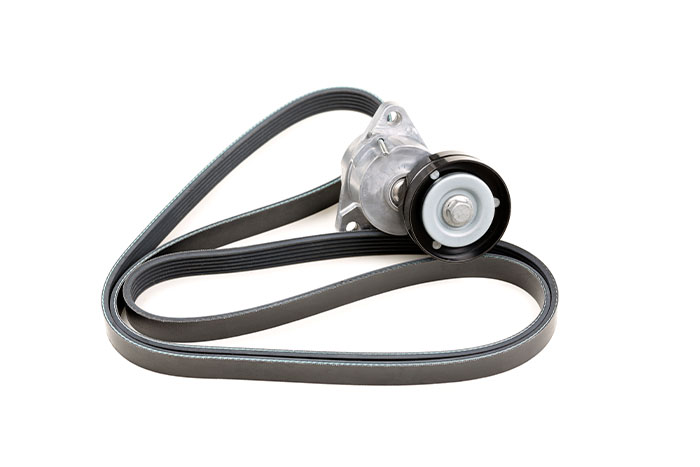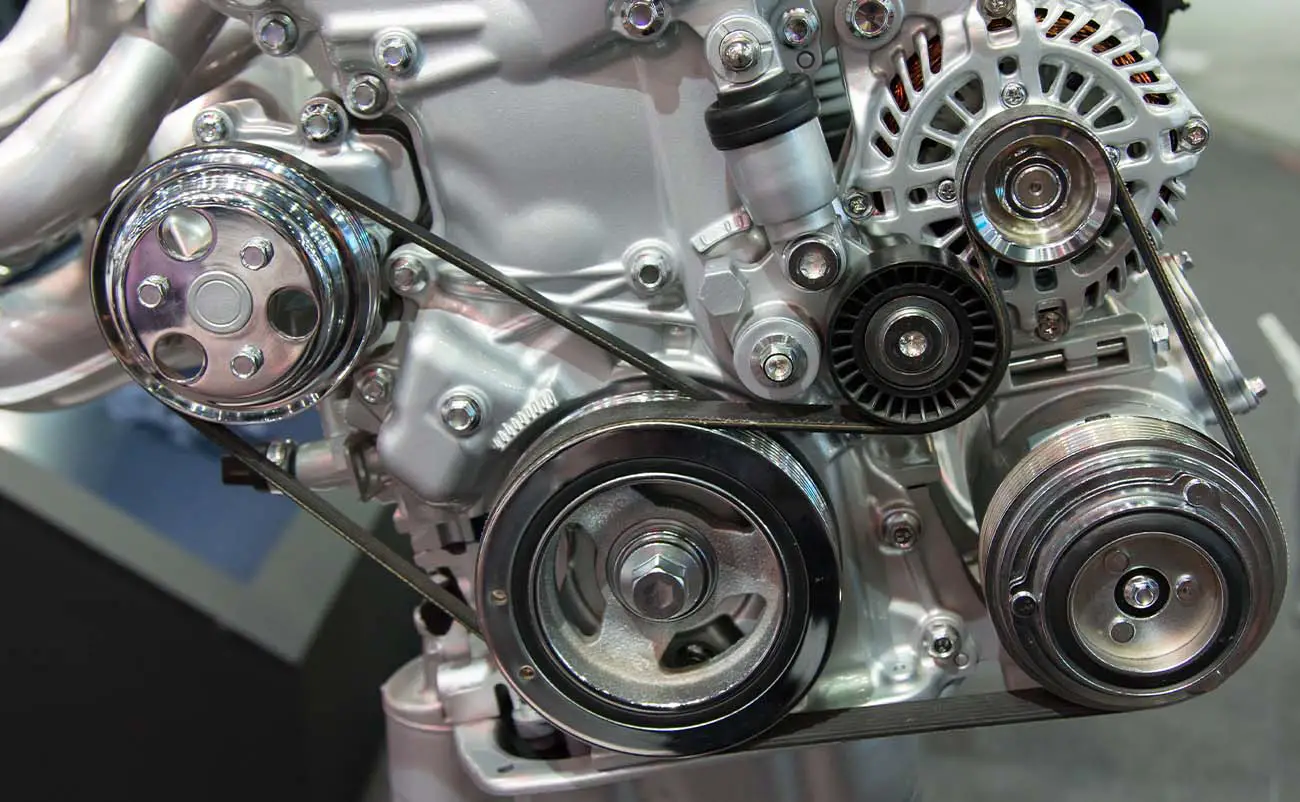Serpentine belts are vital to your car’s operation as they provide power to many accessories and engine systems. If you have ever looked under your vehicle’s hood, you have likely seen your car’s serpentine belt. This belt is the one you can typically see at the front of your engine. It spins many essential accessories like your water pump, power steering pump, air conditioning compressor, alternator, and more. If this belt breaks, you will be unable to drive your vehicle. So, how much will it cost to replace it, and can you perform this task yourself? Keep reading as we give you all the details about replacing a serpentine belt on your vehicle.
Table of Contents
How Much Does A Serpentine Belt Replacement Cost?
When your serpentine belt breaks, you will need to get a replacement right away. Thankfully, replacing the belt is not overly expensive. In most cases, a serpentine belt replacement should cost you around $150 to $200. Most of the cost of this service comes from labor costs. A serpentine belt for some vehicles can be purchased for less than $10. It will generally take a qualified mechanic less than an hour to replace the belt, although most auto repair shops have a one-hour minimum labor charge. For some high-end vehicles, replacing the belt can get more complicated. In these cases, your cost will likely be around $300.
The costs mentioned above assume that you will not need to replace any other parts besides the belt itself. There may be situations where you need to replace an idler pulley or similar part at the same time. This will add to the cost of the job. You should also keep in mind that driving your vehicle without a properly working serpentine belt can quickly cause additional damage to your engine. If you continue driving, your vehicle could overheat. Overheating can lead to extensive engine damage and expensive repair bills. This is why it is important to shut off your vehicle immediately if the belt breaks. You should also replace your belt as preventive maintenance as recommended by your owner’s manual to help avoid breaks while driving.
What Is A Serpentine Belt?

Your car’s engine has many accessories attached to it. These accessories must spin in order to work properly. The serpentine belt, or the drive belt, uses power from the engine to spin the accessories so that they operate. As your engine runs, the crankshaft spins quickly. There is a pulley attached to the crankshaft, and there are pulleys attached to each of the accessories. The serpentine belt routes around each of these pulleys. Therefore, the belt causes all the accessories to spin as the engine runs.
Most vehicles have a belt tensioner located somewhere along the path of the serpentine belt. You can loosen this tensioner for easier removal of the belt. Once the new belt has been installed, the tensioner maintains tight tension on the belt. This prevents slipping, and it keeps the belt firmly in contact with all the pulleys. The tensioner ensures that the belt spins all the accessories properly, as slack in the belt can cause it to slip or break.
Serpentine Belt VS Timing Belt — What’s The Difference?
You may have heard of both a serpentine belt and a timing belt, so what is the difference between the two? These two belts are very different, and they perform vastly different functions. First, your serpentine belt drives your engine accessories. This belt operates your power steering system, alternator, air conditioning, and a few other accessories. If this belt breaks, it can cause engine overheating, a loss of power steering, electrical problems, and other issues. In most cases, you can easily see this belt in your engine bay. Replacing a broken belt is generally not that difficult, and it will likely only cost you about $200.
A timing belt, on the other hand, keeps your pistons and valves operating in sync with each other. The valves in your engine must open and close at precisely the right time as the piston makes its way up and down inside the engine’s cylinders. A broken timing belt can cause these parts to collide with each other in some engines, and that can lead to catastrophic engine damage. When it comes to timing belts, replacing an old belt is much more expensive. These belts are located inside the engine, and the labor costs associated with the job are much more expensive. It will usually cost you anywhere from $600 to $1,200 to have your timing belt replaced.
Common Symptoms Of A Bad Serpentine Belt

So, how can you tell when your serpentine belt is going bad? There will usually be some signs that the belt is going bad before the belt breaks. You will want to go ahead and replace the old belt as soon as these symptoms start to pop up so that you can prevent dealing with a broken belt while driving. Here are the things you need to look for.
— Squealing Sounds
A squealing sound is one of the first signs of a bad serpentine belt. The squealing noise is also hard to miss as it is usually quite loud. The sound is produced when the belt slips on the accessory pulleys. So, this usually means that the belt is getting slightly loose. Belts become stretched and looser over time, and once the belt begins to slip and squeal, it is time for a replacement. Never put oil or lubricant on it to try and stop the squealing! This will only cause the belt to slip more and will result in a bigger problem.
— Power Steering Issues
Another sign of a bad or worn serpentine belt is a problem with your power steering. If you notice that your steering wheel is becoming harder to turn, then it might mean you need a new serpentine belt. Your power steering pump requires the serpentine belt to spin the pump to produce hydraulic pressure. Without the proper pressure, your steering wheel becomes very hard to turn. Once your serpentine belt becomes worn, it can start to slip on the power steering pump pulley. When the belt is slipping, the pulley is not turning. This results in a lack of power steering, and you will notice it when you try to turn the vehicle.
— A/C Not Cooling
During the warmer months, your air conditioning usually works overtime keeping the cabin of your vehicle cool. This requires your serpentine belt to properly turn the air conditioner compressor. If the belt is slipping on the pulley, then the compressor might not be turning fast enough to cool the air properly. When your A/C is blowing hot air, it can signal a few different problems. However, it could be something as simple as a bad serpentine belt or a loose tensioner pulley.
— Engine Overheating
Your car’s cooling system generally relies heavily on the serpentine belt to spin coolant through the system. This is especially true in older vehicles. The belt is connected to the water pump, which spins coolant through the engine and radiator. Coolant does not flow through the system fast enough when the belt starts to get loose. That means that the heat from the engine does not get removed properly. The engine’s temperature continues to increase, and it will eventually overheat. If you do not replace the bad belt, then frequent overheating can lead to much bigger car repair bills.
— Electrical Problems
Your car’s electrical system performs many vital functions, and your alternator is at the heart of the system. It keeps your battery charged while driving, and a bad serpentine belt will wreak havoc on your car’s electronics. You might see the battery light illuminate if the alternator is unable to spin fast enough to output the proper voltage level. You might think you see a sign of a bad alternator, but your serpentine belt could be the problem. This is another reason why a broken serpentine belt will leave you stranded. Your alternator will not work at all, and your battery will die quickly. If you notice your voltage gauge or electronics acting strange, then you should immediately check your serpentine belt.
— Visible Cracks
If you can see small cracks on the belt, then you should replace it right away. The belt should be visually inspected at every oil change, along with your hoses and any separate fan belts. This is an important piece of car maintenance that should not be overlooked. If you take your car to the dealership or an auto repair shop for your oil changes, they will typically perform these visual inspections for you. Any noticeable cracks, tears, or other issues should be immediately addressed. Since the average cost of a belt replacement is less than $200, you should not continue to drive with a worn belt.
DIY Serpentine Belt Replacement
Many people choose to replace their own serpentine belts to save money on labor costs. Replacing a serpentine belt is not a difficult job on most vehicles. You only need a few basic hand tools. First, you should start by locating the serpentine belt in your engine bay. Make sure that you make a note of the routing of the belt before removing the old belt. Many vehicles have a sticker under the hood that shows how the belt is routed. If your vehicle does not have one, you should draw a diagram of the proper routing before removing the belt.
Next, loosen the tensioner pulley and slip the belt off the pulley. Once you slide the belt off the tensioner pulley, you will be able to easily remove it from the other pulleys as well. Route the new belt around each of the pulleys, making sure that you route it exactly as the old belt was routed. Some of the pulleys have grooves so that the ribs on the serpentine belt fit inside them. Lastly, loosen the tensioner pulley and slide the belt over that pulley. Release the pulley, and the belt install should be completed! Crank your car and let it idle for a few minutes before you start to drive to make sure that the belt is operating properly.
The Bottom Line
Replacing a serpentine belt is not an expensive job on most vehicles. Usually, it should cost you less than $200 to have the belt replaced. You can even save some money on labor charges and do the work yourself. A serpentine belt replacement can generally be performed on most vehicles fairly easily as long as you have a little bit of mechanical knowledge. Belts can be purchased for as little as $10 for some vehicles, so you could save quite a bit of cash if you do the work yourself.
Frequently Asked Questions
Can I drive with a bad serpentine belt?
No, you should not drive your car with a bad serpentine belt. If the belt breaks, it will leave you stranded. You cannot run your vehicle without a serpentine belt because your engine accessories will not be running. Items like your alternator and water pump are critical to operating your car. Without these accessories, you could cause further damage to your engine that could lead to a bigger repair bill.
Why do I need a serpentine belt?
You need a serpentine belt because this is what transfers power from your engine to all the accessories. This belt spins your alternator, power steering pump, air conditioning compressor, water pump, and other important engine accessories. Without the belt, these accessories would not be able to operate. This would make it impossible to drive your car because your engine would not run without some of those accessories operating properly.
Can I replace a serpentine belt myself?
Yes, you can replace a serpentine belt on your own on most vehicles. Replacement of the belt only requires a few basic hand tools and some basic mechanical knowledge. Make sure that you take note of the proper routing of the belt before you remove the old one. Failure to route the new belt correctly can cause it to snap immediately, and it could also cause damage to your engine. Replacing the serpentine belt will generally take half an hour or less on most vehicles.

